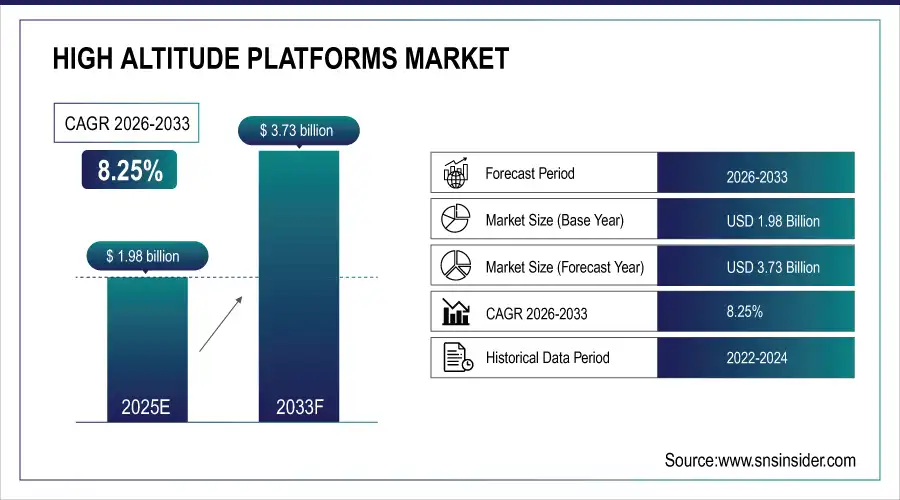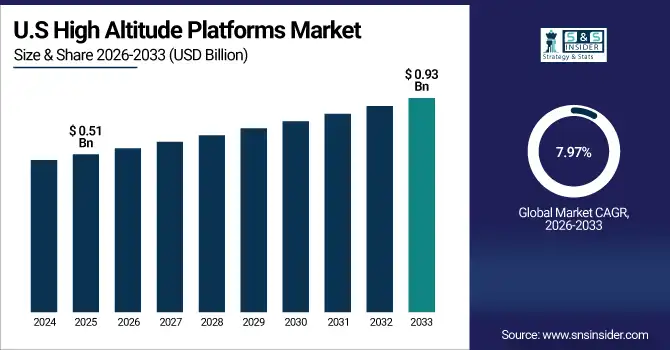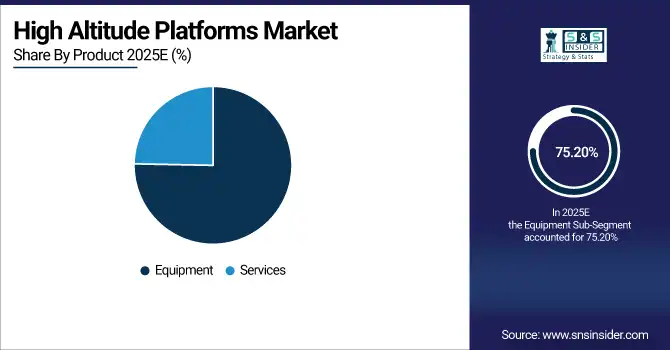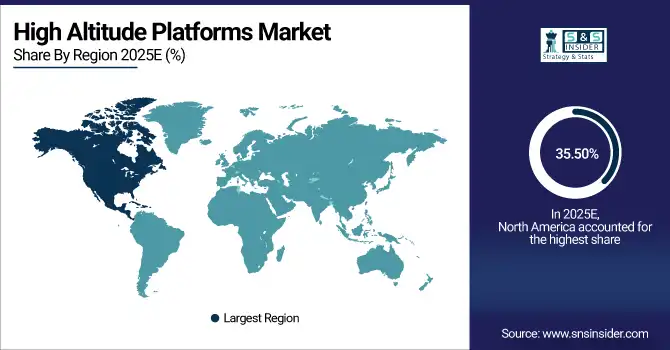High Altitude Platforms Market Report Scope & Overview:
The High Altitude Platforms Market Size was valued at USD 1.98 Billion in 2025E and is expected to reach USD 3.73 Billion by 2033 and grow at a CAGR of 8.25% over the forecast period 2026-2033.
The High Altitude Platforms Market analysis is due to the rising requirement for reliable, wide-area connectivity and communication services. As telecommunication networks continue to expand worldwide and there is growing demand to fill connectivity gaps and congested regions in rural and underprivileged locations, High Altitude Platforms offer a lower-cost solution than traditional satellite and terrestrial networks. This capability to function for long hours at a high altitude enables constant communication, IoT support, and broadband services that appeal tremendously for commercial uses of telecommunications, media, and disaster management. Moreover, the application of HAPs for intelligence, surveillance, and reconnaissance (ISR) by the government and defense sector is also boosting the demand for the market. According to study, HAPs operate at altitudes of 17–22 km, which allows them to maintain continuous line-of-sight communication for extended periods.
Market Size and Forecast:
-
Market Size in 2025: USD 1.98 Billion
-
Market Size by 2033: USD 3.73 Billion
-
CAGR: 8.25% from 2026 to 2033
-
Base Year: 2025
-
Forecast Period: 2026–2033
-
Historical Data: 2022–2024

To Get more information On High Altitude Platforms Market - Request Free Sample Report
High Altitude Platforms Market Trends
-
Expanding broadband and IoT connectivity drives high altitude platform adoption globally.
-
Rising government investments in remote region communication infrastructure support market growth.
-
Persistent high-altitude operations enable continuous surveillance, monitoring, and emergency communications.
-
Emerging markets in Asia Pacific, Latin America, Africa offer significant expansion potential.
-
Commercial applications like disaster management, agriculture, and logistics increase platform utilization.
-
Hybrid solar and fuel-powered platforms improve efficiency, endurance, and operational cost-effectiveness.
The U.S. High Altitude Platforms Market size was USD 0.51 Billion in 2025E and is expected to reach USD 0.93 Billion by 2033, growing at a CAGR of 7.97% over the forecast period of 2026-2033, driven by increasing defense and government investments, advanced aerospace technology, rising demand for reliable connectivity, and deployment of airships, UAVs, and stratospheric platforms for communication, surveillance, and environmental monitoring.

High Altitude Platforms Market Growth Drivers:
-
Rising Demand for Reliable Connectivity Fuels High Altitude Platforms Growth
The High Altitude Platforms Market holds great potential and is poised for growth, primarily driven by the demand for reliable wide-area connectivity in remote and underserved regions. The high cost of building infrastructure and technical restrictions placed on traditional terrestrial networks and satellite systems that offer broadband have made it difficult to provide uniform subscription access in rural or difficult-to-reach regions. They include numerous high-altitude platforms (HAPs) like airships, stratospheric balloons, and fixed-wing solar powered systems, which can remain in the high altitudes for longer periods of time, providing persistent connectivity over a wide geographic area. Their ability to evolve and adapt makes them highly relevant for applications, including Internet of Things (IoT) networks, telecommunication expansion, media broadcasting, and emergency response communication.
Platforms like airships, stratospheric balloons, and fixed-wing solar-powered systems can operate at altitudes between 17–22 km, enabling extended and uninterrupted communication.
High Altitude Platforms Market Restraints:
-
High Capital Expenditure and Operational Costs Challenge Platform Adoption Globally
Despite its advantages, the main factor limiting the adoption of high-altitude platforms is the high upfront cost of development, production and deployment. Due to the high development costs associated with advanced HAP systems providing long endurance, large payload capacity, and more complex power sources for efficient operation, The cost is further heightened by operational costs, such as maintenance, fuel (for platforms without solar), and the requirement for trained personnel to observe and operate these platforms. This will impact the penetration rate of high-altitude platforms as it could prevent smaller companies or emerging markets from adopting them based on the more challenging financial pressures of deploying this technology. Additionally, regulatory compliance and airspace management are stringent and make operations more complex and expensive.
High Altitude Platforms Market Opportunities:
-
Emerging Markets and Commercial Applications Create Significant Growth Opportunities Ahead
The Expansion in Emerging Asia Pacific, Latin America, and Africa is one of the high growth opportunities for the high-altitude platforms market. The regions have huge rural populations, many of whom have little or no access to dependable connectivity, and where demand for affordable alternatives to satellite and terrestrial networks is very great. Further, several commercial applications other than telecommunication exposed areas like environmental monitoring, precision agriculture, disaster management, and logistics tracking are also generating bark bark. Companies can capitalize on these opportunities by developing tailored HAP solutions, collaborating with governments and private enterprises, and implementing hybrid models of solar and fuel-powered systems for better operational efficiency and coverage.
Expanding into non-telecom sectors can potentially increase overall market revenue by 15–20% over the next decade.
High Altitude Platforms Market Segmentation Analysis:
-
By Type: In 2025, Airships led the market with a share of 38.10%, while Unmanned Aerial Vehicles (UAV) is the fastest-growing segment with a CAGR of 10.08%.
-
By Product: In 2025, Equipment led the market with a share of 75.20%, while Services is the fastest-growing segment with a CAGR of 9.40%.
-
By Application: In 2025, Connectivity and Communication led the market with a share of 40.30%, while Intelligence, Surveillance, and Reconnaissance (ISR) is the fastest-growing segment with a CAGR of 9.20%.
-
By End Use: In 2025, Government & Defense led the market with a share of 60.30%, while Commercial is the fastest-growing segment with a CAGR of 9.10%.
By Type, Airships Lead Market and Unmanned Aerial Vehicles (UAV) Fastest Growth
In the High Altitude Platforms Market, the Airships segment leads the market in 2025, due to their ability of persistent coverage over large areas and multiple applications, which includes Connectivity, Media, broadcasting, Significant progress is being made in Earth observation, environmental monitoring, and they are increasingly gaining significant strategic attention. These features make airships highly suitable for commercial but also for government deployments due to their long endurance, high payload capacity, and dependable operation at high altitudes. Additionally, the UAV (Unmanned Aerial Vehicles) segment will have the most rapid growth, owing to technological breakthroughs in autonomous flight, low-cost operational capabilities, and a rise in demand for intelligence, surveillance, reconnaissance, and precision monitoring. These segments collectively highlight market growth for a range of use cases.
By Product, Equipment Leads Market and Services Fastest Growth
The Equipment segment lead the High Atitude Platforms Market, due to the demand for advanced hardware including airships, stratospheric balloons, and fixed-wing platforms, which become the backbone of the high-altitude platforms operations. Component level capabilities in terms of persistent connectivity, surveillance, environmental monitoring and telecommunications applications propel the segment with unprecedented regional spear heading in following the lead in terms of established value chain across developed and emerging markets. while, the Services segment is fastest-growing segment, due to increasing need for operational support, maintenance, data analytics, and integration services. Such a mix of equipment supremacy and quickening services growth indicates increasing global uptake and commercialization of high altitude platform systems.

By Application, Connectivity and Communication Lead Market and ISR Fastest Growth
In the High Altitude Platforms Market, the Connectivity and Communication segment leads the market, Due to the increasing demand for reliable broadband, telecommunication expansion, and Internet of Things connectivity in remote and underserved areas. High altitude platforms provide persistent, wide-area coverage, making them ideal for media broadcasting, emergency communication, and large-scale network deployment. Meanwhile, the Intelligence, Surveillance, and Reconnaissance (ISR) segment is projected to witness the fastest growth, driven by increasing adoption in defense, government, and security applications. The combination of connectivity dominance and ISR growth underscores the strategic importance of high-altitude platforms across both commercial and government sectors.
By End Use, Government & Defense Lead Market and Commercial Fastest Growth
In the High Altitude Platforms Market, the Government & Defense segment leads the market in 2025, owing to the rising need for intelligence, surveillance, reconnaissance, and secure communication applications. The ability to have persistent coverage, real-time data transfer capabilities, and operational efficiency makes high altitude platforms very suitable for defense operations, border monitoring, and disaster response. Meanwhile, the Commercial segment is expected to grow the fastest, as adoption is increasing in telecommunications, media broadcasting, environmental monitoring, logistics tracking, and precision agriculture. Together the strong government applications and rapid commercial adoption signify global increasing use of high altitude platforms in public and private sectors.
High Altitude Platforms Market Regional Analysis:
North America High Altitude Platforms Market Insights:
The High Altitude Platforms Market in North America held the largest share 35.50% in 2025, due to relatively matured aerospace infrastructure, high technology developers, and considerable defense and government expenditure in this region. It also enjoys the widespread use of airships, stratospheric balloons, and unmanned aerial vehicles for connectivity, intelligence, surveillance, reconnaissance, and environmental monitoring in the region. High altitude platforms are being adopted more with the growing investments by government agencies, defense organizations, and commercial telecom operators among others. Moreover, the North America high altitude platforms market is further gaining strength owing to the fast pace of adoption of modern technologies, growing supportive regulations, and collaborations between the key players.

Get Customized Report as per Your Business Requirement - Enquiry Now
United States and Canada Lead High Altitude Platforms Market Growth and Adoption
The United States and Canada dominate due to high defense spending, advanced aerospace technology, government initiatives, and extensive deployment of airships, balloons, and UAVs for connectivity and surveillance.
Asia-Pacific High Altitude Platforms Market Insights
In 2025, Asia-Pacific is the fastest-growing region in the High Altitude Platforms Market, projected to expand at a CAGR of 9.08%, owing to the the rapid deployment of telecommunication networks, increasing investment for Internet of Things (IoT) infrastructure, and the rising adoption of high altitude platform (HAP) system platforms that can be utilized in environmental monitoring, disaster management, and precision agriculture. Airships, stratospheric balloon deployments, and fixed wing systems powered silently by the Sun, provide cost-effective solutions to improved communication, as well as regional data collection. Further, these technologies are gaining traction with the support of government initiatives, favorable legislation, and collaboration with commercial entities to enable rapid access to scalability.
China and India Emerge as Key Growth Engines in High Altitude Platforms Market
China and India are emerging as key markets, fueled by rapid digital transformation, large rural populations needing connectivity, government-backed aerospace projects, and rising adoption of high altitude platforms for communication and defense.
Europe High Altitude Platforms Market Insights
Europe holds a significant position in the High Altitude Platforms Market, owing to aerospace technology availability, robust research & development capabilities and increased investment opportunities for communication & surveillance infrastructure in European region. Airships, stratospheric balloons, and fixed-wing solar-powered systems are being steadily adopted in this region for various applications, including connectivity, environmental monitoring, disaster management, and intelligence, surveillance, and reconnaissance. The growing emphasis on the upgrading of communication infrastructure, implementation of Internet of Things solutions, and improved workflow is fueling the market expansion. Moreover, growing supportive regulatory scenarios, partner establishment between industry leaders alongside technological progression will fortify Europe, leading to a static yet evolutionary high altitude platforms market.
Germany, France, and United Kingdom Drive Europe High Altitude Platforms Growth
Germany, France, and the United Kingdom lead the market, supported by strong R&D capabilities, advanced aerospace infrastructure, strategic partnerships, and growing adoption for communication, ISR, and environmental monitoring.
Latin America (LATAM) and Middle East & Africa (MEA) High Altitude Platforms Market Insights
High Altitude Platforms Market in LATAM and MEA IS growing at a steady pace, due to the high demand and need for reliable connectivity and surveillance solution across larger and unserved areas. The demand for closing the digital gap in LATAM seen especially in rural and remote areas is accelerating adoption, with government and telecom operator actors considering low-cost HAP broadband and emergency communication solutions. While this is happening, high investments in defense, border monitoring, disaster management, and environmental monitoring are supporting demand in MEA. High altitude platforms will appeal due to the immense geography of the regions along with the very sparse terrestrial infrastructure supporting future market development across both regions.
High Altitude Platforms Market Competitive Landscape
Airbus is a market leader in high altitude platforms, primarily through its Zephyr program. The company focuses on long-endurance solar-powered UAVs for persistent connectivity, surveillance, and environmental monitoring. Airbus continues expanding HAP applications in commercial and defense sectors, driving technological advancements and strategic partnerships globally.
-
In May 2025, Airbus subsidiary AALTO HAPS achieved a significant milestone by completing a 67-day continuous flight of its Zephyr High Altitude Platform Station (HAPS) in the stratosphere.
Lockheed Martin develops advanced high altitude platforms and UAV systems for defense, intelligence, and communication applications. Their platforms emphasize long-endurance operations, real-time data collection, and ISR capabilities. By integrating cutting-edge aerospace technologies, Lockheed Martin strengthens HAP adoption for government and commercial use, supporting connectivity and surveillance needs worldwide.
-
In September 2025, Lockheed Martin Skunk Works unveiled the Vectis™ Group 5 unmanned aerial system, designed for high-altitude, long-endurance missions with ISR, electronic warfare, and precision strike capabilities.
Israel Aerospace Industries (IAI) is actively advancing in the High Altitude Platforms (HAPs) sector, focusing on high-end unmanned aerial systems (UAS) for surveillance, reconnaissance, and communication. Their Heron TP UAV, capable of operating at high altitudes, exemplifies their commitment to providing persistent, wide-area coverage for defense and commercial applications.
-
In May 2024, Israel Aerospace Industries’ Heron TP UAV completed its maiden flight with the German Air Force, demonstrating high-altitude surveillance and reconnaissance capabilities for defense and commercial applications.
High Altitude Platforms Market Key Players:
Some of the High Altitude Platforms Market Companies are:
-
Airbus SE
-
Lockheed Martin Corporation
-
Northrop Grumman
-
Raytheon Technologies Corporation
-
Thales Group
-
Israel Aerospace Industries (IAI)
-
AeroVironment, Inc.
-
Prismatic Ltd.
-
TCOM L.P.
-
Boeing
-
General Atomics
-
BAE Systems
-
Sierra Nevada Corporation (SNC)
-
Lindstrand Technologies Ltd.
-
Elektra Solar GmbH
-
Worldwide Aeros Corporation
-
Rafael Advanced Defense Systems Ltd.
-
ILC Dover L.P.
-
Avealto Ltd.
-
Aaronia AG
| Report Attributes | Details |
|---|---|
| Market Size in 2025E | USD 1.98 Billion |
| Market Size by 2033 | USD 3.73 Billion |
| CAGR | CAGR of 8.25 % From 2026 to 2033 |
| Base Year | 2025E |
| Forecast Period | 2026-2033 |
| Historical Data | 2022-2024 |
| Report Scope & Coverage | Market Size, Segments Analysis, Competitive Landscape, Regional Analysis, DROC & SWOT Analysis, Forecast Outlook |
| Key Segments | • By Type (Airships, Stratospheric Balloons, Fixed-wing Solar HAPS, Tethered Aerostats, Others) • By Product (Equipment, Services) • By Application (Connectivity and Communication, Intelligence, Surveillance, and Reconnaissance (ISR), Weather and Environmental Monitoring, Navigation and Remote Sensing, Others) • By End Use (Government & Defense, Commercial) |
| Regional Analysis/Coverage | North America (US, Canada), Europe (Germany, UK, France, Italy, Spain, Russia, Poland, Rest of Europe), Asia Pacific (China, India, Japan, South Korea, Australia, ASEAN Countries, Rest of Asia Pacific), Middle East & Africa (UAE, Saudi Arabia, Qatar, South Africa, Rest of Middle East & Africa), Latin America (Brazil, Argentina, Mexico, Colombia, Rest of Latin America). |
| Company Profiles | Airbus SE, Lockheed Martin Corporation, Northrop Grumman, Raytheon Technologies Corporation, Thales Group, Israel Aerospace Industries (IAI), AeroVironment, Inc., Prismatic Ltd., TCOM L.P., Boeing, General Atomics, BAE Systems, Sierra Nevada Corporation (SNC), Lindstrand Technologies Ltd., Elektra Solar GmbH, Worldwide Aeros Corporation, Rafael Advanced Defense Systems Ltd., ILC Dover L.P., Avealto Ltd., Aaronia AG, and Others. |

